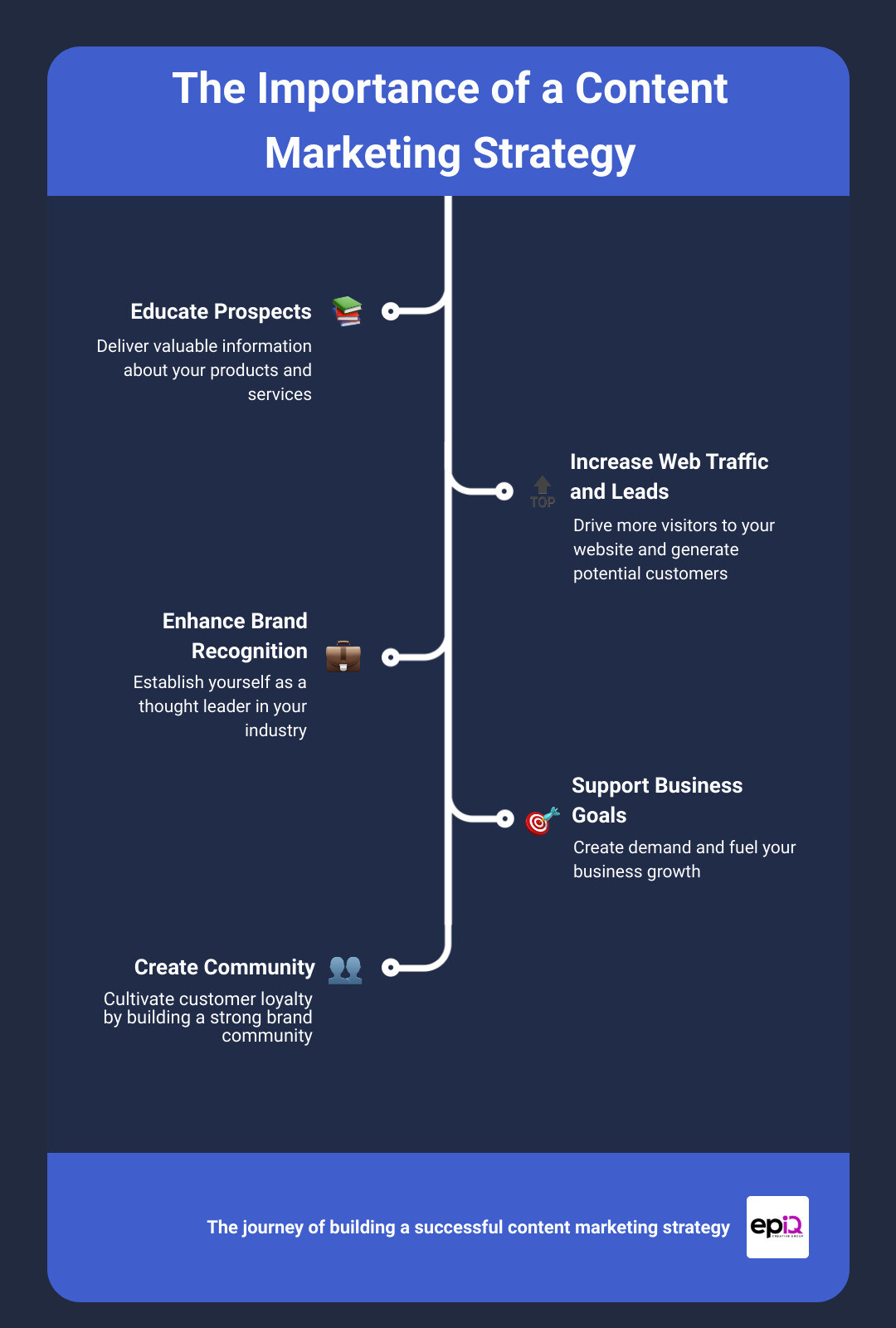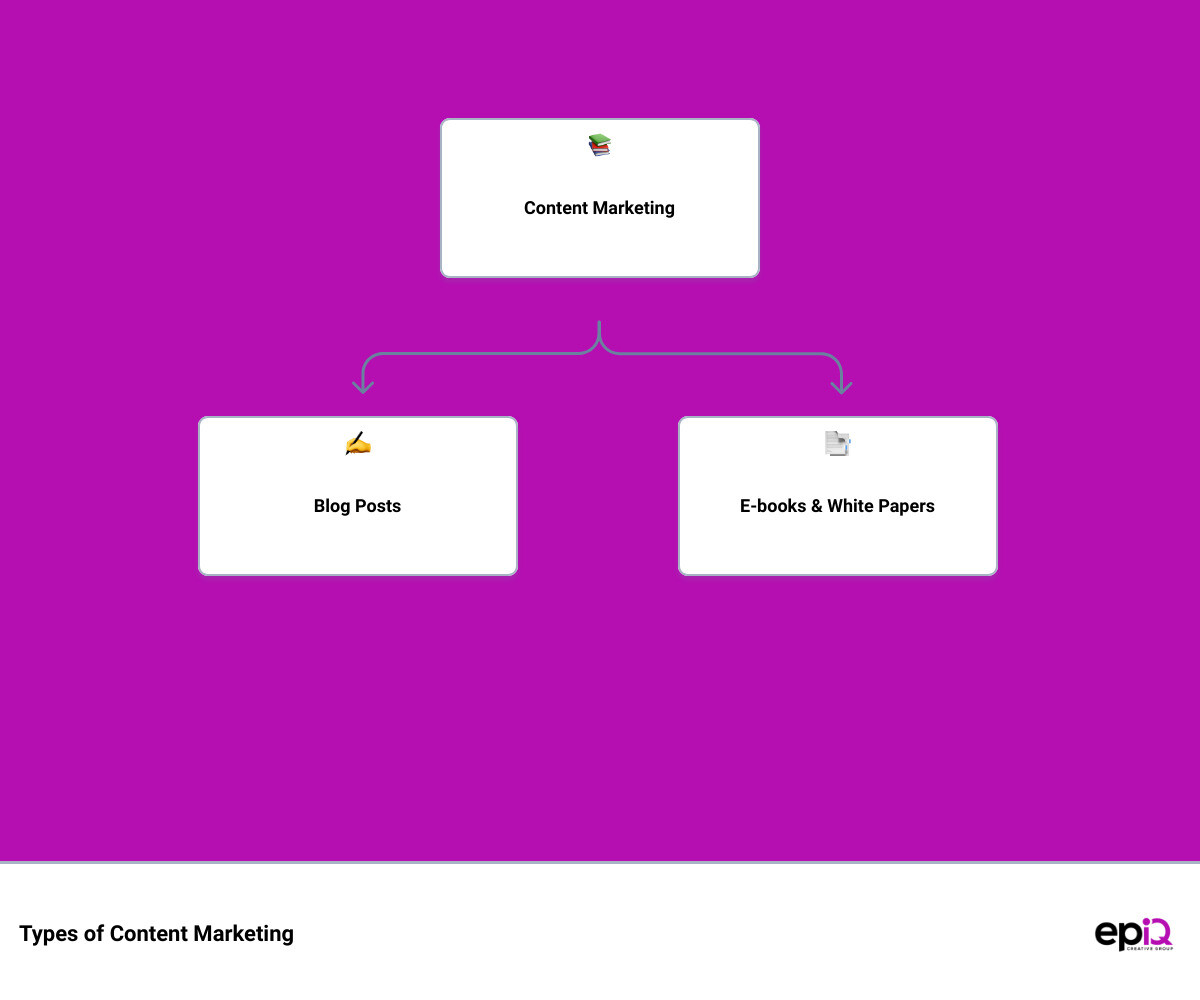Marketing today is like navigating an ever-changing labyrinth. With constant changes and an array of channels to exploit, it could feel overwhelming. It is especially true for businesses attempting to scale their online visibility and engagement without a stable plan in place. If you’ve ever wondered how to stay consistent, relevant, and effective in getting your brand’s message across, you’ve probably ventured into the realm of building a content marketing strategy.
The world today is crowded with content. As a result, standing out and maintaining a solid connection with your audience can be a significant challenge for businesses. However, those who rise above the noise and make an impact are the ones with an effective content marketing strategy in play. As the experts at epIQ Creative Group, we understand that a well-crafted content marketing strategy is the lifeblood of successful businesses. It is your guide and roadmap in the online marketing playground.
A comprehensive content marketing strategy boosts conversions, nurtures customer relationships, fosters a sense of community around a brand, and provides a blueprint for getting your message across to your target audience. It incorporates essential elements like content marketing content strategy, marketing and content strategy, and content marketing strategies, shaping a framework that supports your long-term business goals and the needs of your audience.
The Importance of a Content Marketing Strategy:
* Educates leads and prospects about your products and services
* Increases website traffic and lead generation
* Enhances your brand recognition and reputation, making you a thought leader in your industry
* Supports achievement of your business goals by driving demand to your brand
* Creates a sense of community around your brand, leading to increased customer loyalty.

In the following sections, we will delve more in-depth into each aspect of crafting a successful content marketing strategy. We will lay out a roadmap that you can follow to adjust and enhance your approach to marketing, polish your brand’s story, and maximise your reach and engagement with your customers. This is our definitive guide – The Ultimate Guide to Crafting an Effective Content Marketing Strategy.
Understanding Content Marketing and Its Types
Content marketing is the lifeblood of a successful digital marketing strategy. It’s the music that resonates with your audience and sets the tone for your brand’s story. But what exactly is content marketing? And what are the different types we can leverage to engage with our audience effectively?
Definition of Content Marketing
Content marketing is the strategic process of creating, publishing, and distributing valuable and relevant content to attract, engage, and retain a clearly defined audience. It’s all about providing your audience with the information they need, when they need it, and in a format that they find engaging and valuable.
Unlike traditional marketing tactics that often interrupt your audience’s day-to-day activities, content marketing takes a more subtle and organic approach. It revolves around the creation of content that your audience naturally gravitates towards because it provides value or solves a problem they have. This inbound approach to marketing is all about building trust and relationships, positioning your brand as a thought-leader, and ultimately driving profitable customer actions.
The Different Types of Content Marketing
Content marketing comes in many shapes and sizes. The type of content you choose to create will largely depend on your audience’s preferences, your industry, and your specific business goals. Here are some of the most common types of content marketing:
-
Blog Posts: Blogging is a powerful way to attract visitors to your site, provide valuable information, and establish your brand as an authority in your field. Blogs should be informative, engaging, and SEO-optimized to drive organic traffic.

-
E-books & White Papers: These in-depth pieces of content provide comprehensive insights on a particular topic. They are excellent for generating leads as they are often exchanged for contact information.
-
Infographics: Infographics simplify complex information into easily digestible, visually appealing content. They are fantastic for social sharing and can significantly increase engagement.

-
Videos: Video content is highly engaging and can effectively convey your message in a short time. They can be tutorials, product demos, customer testimonials, or brand stories.
-
Webinars: Webinars are live, interactive sessions that allow you to connect directly with your audience. They’re perfect for demonstrating thought leadership and building relationships.
-
News Articles: News articles keep your audience informed about the latest developments in your industry or company, helping establish your brand as a reliable source of information.
-
Research: Original research, surveys, or reports can boost your credibility and provide valuable insights that your audience can’t find elsewhere.
-
Social Media Posts: Social media posts can drive traffic, increase engagement, and allow you to connect directly with your audience. They should be engaging, shareable, and align with your brand’s voice.
-
Slideshares: Slideshares are visual content pieces that allow you to share presentations, infographics, or other visual content with a wide audience. They are excellent for B2B marketing and professional branding.
Remember, the key to successful content marketing is to create content that aligns with your audience’s needs and preferences. By leveraging a mix of these content types, you can attract a wider audience, engage them effectively, and build lasting relationships. Your content strategy should be a symphony of different content types, each playing a vital role in attracting, engaging, and converting your audience.
The Key Elements of a Successful Content Marketing Strategy
Before launching your content marketing campaign, you need to lay a strong foundation. This involves defining your content marketing goals and objectives, identifying your target audience, understanding your brand story, establishing your business case for content marketing, and developing an action plan for your strategy.
Defining Your Content Marketing Goals and Objectives
Building a content marketing strategy begins by identifying your goals and objectives. As we often advise our clients at epIQ Creative Group, your goal isn’t just to churn out content, but to create purposeful content that supports your business objectives.
Your goals could range from improving brand visibility and increasing website traffic to generating leads and boosting sales. However, remember that content marketing is part of the long game. It’s not just about immediate results but about establishing your brand as a thought leader in your industry, which in turn fosters trust and drives revenue in the long run.
Identifying Your Target Audience and Creating Buyer Personas
The next step is understanding your audience. Creating detailed personas of your ideal customers, including their demographics, interests, pain points, and buying behavior, enables you to tailor your content to resonate with your target audience.
This detailed understanding of your audience will help you deliver value to them, ensuring that your content doesn’t just come off as salesy, but as a valuable resource that helps them learn and solve their problems.
Understanding Your Brand Story and Content Marketing Mission
Your brand story is more than just the history of your company. It’s a narrative that encapsulates your values, mission, and what sets you apart from the competition. A compelling brand story can engage your audience and cultivate brand loyalty.
Moreover, your content marketing mission should be clear and should align with your brand story. This mission will guide your content creation, helping you stay focused and consistent in delivering your brand message.
Establishing Your Business Case for Content Marketing
Content marketing is an investment. It requires time, resources, and commitment. Therefore, it’s essential to establish a strong business case for your content marketing strategy.
This involves showing how content marketing can help achieve your business goals, the potential return on investment (ROI), and how it compares to other marketing strategies in terms of cost-effectiveness and long-term benefits.
Developing an Action Plan for Your Content Marketing Strategy
Once your goals are set, your audience is identified, your brand story is articulated, and your business case is established, it’s time to develop an action plan.
This plan should outline your content marketing tactics, including the types of content you’ll create, your content distribution channels, your content calendar, and how you plan to measure your progress and success.
In conclusion, building a successful content marketing strategy involves meticulous planning and a deep understanding of your business, your audience, and your market. By identifying these key elements, you can create a content marketing strategy that not only resonates with your audience but also drives your business towards its goals.

In the next section, we’ll walk you through the steps to building an effective content marketing strategy. Stay tuned!
Steps to Building an Effective Content Marketing Strategy
Creating a winning content marketing strategy requires a strategic approach and a deep understanding of your audience. The following steps will guide you through this process, helping you create a content marketing strategy that delivers results.
Conducting a Content Audit and Analyzing Historical Content Performance
The first step in building a content marketing strategy is to take a close look at your existing content. A content audit helps you understand what’s working, what’s not, and where opportunities for improvement lie. As we at epIQ Creative Group always say, you cannot improve what you don’t measure!
Start by creating an inventory of your content assets – blog posts, infographics, videos, podcasts, social media posts, webinars, white papers, and more. Using tools like Google Analytics and social media analytics, review and analyze the performance of each content piece. Metrics to consider include page views, shares, comments, bounce rate, and conversions.
Identify your best-performing content in terms of topics, keywords, and formats. This will guide your future content creation efforts. Conversely, pinpoint underperforming content, understand why they fell short, and learn from these missteps. Don’t discard underperforming content right away. Some of it might just need a bit of sprucing up – updating outdated information, improving SEO, adding fresh visuals, or repurposing it into a new format.
Finally, document your findings. This documentation will serve as a valuable resource when planning your future content strategy.
Choosing the Right Content Management System
Next, it’s crucial to choose a content management system (CMS) that suits your needs. A CMS helps you manage and organize your content, making it easier to publish, edit, and manage everything in one place.
Determining the Types of Content You Want to Create
After you’ve conducted your audit and chosen your CMS, it’s time to decide on the types of content you wish to create. This should be guided by your target audience’s preferences, your business objectives, and the insights gathered from your content audit.
Brainstorming Content Ideas and Developing a High-Level Editorial Plan
The next step is to brainstorm content ideas. Consider your audience’s needs, interests, and challenges. What questions do they have? What problems are they trying to solve? Use these insights to develop a high-level editorial plan that outlines the topics you’ll cover, the types of content you’ll create, and the key messages you want to convey.
Creating a Content Calendar for Publishing and Managing Your Content
Lastly, create a content calendar for publishing and managing your content. This can be a simple spreadsheet or a more sophisticated tool, depending on your needs. A content calendar helps ensure that your content is published consistently and aligns with your overall business goals. It also enables you to plan ahead for key events or dates relevant to your audience.
Building an effective content marketing strategy is a continuous process that requires regular reevaluation and adjustment. But with a thorough understanding of your audience, clear goals, and a solid plan in place, you’ll be well on your way to crafting content that resonates, engages, and drives results.

Stay tuned for the next section where we will delve into the implementation of your content marketing strategy.
Implementing Your Content Marketing Strategy
Now that you have a well-defined content marketing strategy, it’s time to bring it to life. The implementation of your content marketing strategy involves creating and curating engaging content, distributing it through the right channels, and optimizing it for organic search. Let’s explore these steps in detail.
Creating and Curating Engaging Content
The heart of any content marketing strategy lies in the creation of high-quality, engaging content. Remember, it’s not about churning out as much content as possible, but about producing content that resonates with your target audience and aligns with your business objectives.
Start by focusing on originality. Original content not only helps you stand out from the crowd, but it also positions your brand as a thought leader in your industry. Whether it’s providing a fresh perspective on a trending topic or sharing an insightful case study, original content can significantly enhance your brand’s credibility and engagement.
In addition to creating original content, consider repurposing existing content. This could involve transforming a long-form blog post into an infographic or a series of social media posts. Repurposing content allows you to extend its shelf life and reach a broader audience.
Remember to maintain a high standard of quality. Your content should be clear, concise, and compelling. It should also align with your brand’s tone of voice and be free from errors.
Publishing and Promoting Your Content on Chosen Channels
Once you’ve created your content, it’s time to publish and promote it. The channels you choose for distribution will depend on where your audience spends most of their time. Are they active on social media platforms like LinkedIn or Facebook? Do they prefer to receive information via email? Choosing the right distribution channels is crucial for reaching your target audience effectively.
Promotion is an equally important part of your content marketing strategy. Even the most engaging content can fall flat if it fails to reach your intended audience. Consider using a mix of organic and paid promotional strategies to maximize your content’s reach. This could involve sharing your content on social media, sending it to your email subscribers, or even leveraging influencer partnerships to extend your reach.
Optimizing Your Content for Organic Search and Considering Paid Channels for Promotion
Lastly, ensure your content is optimized for organic search. Organic traffic can account for a significant portion of total website traffic, making search engine optimization (SEO) a crucial aspect of your content marketing strategy.
Optimizing your content for SEO involves using relevant keywords strategically, ensuring your content is readable and well-structured, and following SEO best practices such as proper internal linking and the use of meta tags.
Paid promotion, on the other hand, involves leveraging paid channels like Google Ads or sponsored social media posts to increase your content’s visibility. While paid promotion involves an investment, it can significantly extend your content’s reach and drive more traffic to your website.
Implementing a content marketing strategy requires careful planning and execution, but the results are worth the effort. Stay tuned for our next section, where we’ll discuss how to measure the success of your content marketing strategy and make necessary adjustments. Keep in mind, success in content marketing doesn’t happen overnight. It’s a continuous cycle of planning, implementing, analyzing, and refining. But with persistence and the right strategy, you can achieve your content marketing goals and drive meaningful results for your business.
Measuring the Success of Your Content Marketing Strategy
The moment of truth in any marketing strategy arrives when it’s time to measure success. Unless you can quantify the impact of your content marketing efforts, you cannot assess their effectiveness or make informed decisions about future strategies. Here, we’ll walk you through how to set Key Performance Indicators (KPIs), use analytics tools to measure results, and make improvements based on content performance analysis.
Setting Key Performance Indicators (KPIs) for Your Content Marketing Efforts
Setting KPIs allows you to define what success looks like for your content marketing strategy. Your KPIs will depend on your overall business goals and the specific objectives of your content marketing efforts. For example, if your aim is to increase brand awareness, your KPIs might include metrics like website traffic, social media engagement, and the number of shares your content receives. Conversely, if you’re focused on lead generation, you might prioritize metrics like the number of leads generated, the conversion rate, and the cost per lead.
You may also establish primary metrics and secondary metrics for each goal. Primary metrics might include revenue generated by content marketing, organic traffic, and the number of leads. Secondary metrics could be rankings and shares. This way, you’ll have a more nuanced understanding of your content marketing performance.
An example of a goal could be: “In 2022, we want to achieve a 20% increase in revenue created by organic content and generate 15,000 qualified leads with a budget of $30,000.” Remember, your goals and KPIs are not set in stone, they can and should be adjusted as your business grows and evolves.
Using Analytics Tools to Measure the Results of Your Content Marketing Efforts
Once you’ve defined your KPIs, you need reliable tools to measure them. Google Analytics is a powerful tool that can provide a wealth of data on your content’s performance. It can help you understand how each blog post is performing in search, the keywords each post is ranking for, your position in search, and the number of clicks versus impressions.
It’s important to set up and configure Google Analytics before you start so you don’t miss any crucial data. This includes determining how you will track your metrics in advance and deciding how you will combine and present that data each month so your team gets the information they need to make decisions.
Making Improvements Based on Content Performance Analysis
The final step in measuring the success of your content marketing strategy is making improvements based on content performance analysis. Here, you’ll use the data you’ve gathered to identify what’s working, what’s not, and where there’s room for improvement.
For instance, you may find that certain topics, keywords, or content formats are performing better than others. You can then focus on creating more content around these successful elements. On the other hand, if some pieces of content aren’t resonating with your audience or achieving your goals, you’ll need to understand why and make necessary adjustments.
This process of measurement and analysis is not a one-off task, but a continuous cycle of refining and improving your content marketing strategy. As we at epIQ Creative Group know, the more frequently you measure and analyze your content, the better equipped you’ll be to stay ahead in the content marketing game.
In conclusion, measuring the success of your content marketing strategy is a crucial step that should not be overlooked. By setting clear KPIs, utilizing robust analytics tools, and making data-driven improvements, you can ensure your content marketing efforts are yielding the desired results and driving your business forward.

Stay tuned for our next section where we’ll delve into the continuous cycle of content marketing strategy, emphasizing that successful content marketing is a journey, not a destination.
Conclusion: The Continuous Cycle of Content Marketing Strategy
Just as the sun sets only to rise again, the cycle of content marketing strategy is continuous and ever-evolving. It’s not a one-and-done project but a constant process of strategizing, implementing, analyzing, and refining. With every turn of the cycle, valuable insights are gained and lessons are learned, making each new round more potent and effective than the last.
Firstly, remember that monitoring and refining play a pivotal role in shaping a successful content marketing strategy. As highlighted by Forbes Agency Council, your strategy must be flexible and adaptable. Monitor the success of your campaigns, identify what works and what doesn’t, and refine your strategy accordingly.
Content marketing is also a long-term game. As we often remind our clients at epIQ Creative Group, the aim is to establish yourself as a thought leader in your space and drive value to your audience, thereby generating demand for your brand. It’s about building relationships and trust, which take time to solidify.
In the words of Amy Wright, a content marketing strategy is akin to a roadmap for your business. It provides direction and purpose to your content creation efforts. Remember, a documented content marketing strategy is often a key indicator of content marketing success.
Moreover, take into account that your strategy needs to be fluid. Markets change, audience preferences shift, and new trends emerge. Your strategy should be dynamic enough to adapt to these changes and seize new opportunities. Embrace the constant evolution as a chance to innovate and stay ahead of the curve.
Lastly, it’s important to note that the success of your content marketing strategy relies on various content strategy tactics, such as blog posts, ebooks, case studies, infographics, and social media. Be sure to explore and experiment with different types of content to keep your strategy fresh and your audience engaged.
In conclusion, building an effective content marketing strategy is a continuous journey of learning, adapting, and improving. It’s a cyclical process that requires constant attention and refinement. But rest assured, the results are worth the effort. With a well-thought-out and efficiently executed content marketing strategy, your business can effectively engage your audience, boost your brand visibility, and drive growth for years to come.
At epIQ Creative Group, we’re here to assist you every step of the way. Our team of experienced content marketing strategists is ready to help you craft a content marketing strategy that drives results. Let’s start this exciting journey together! Contact us today to learn more about our comprehensive range of content marketing services.

